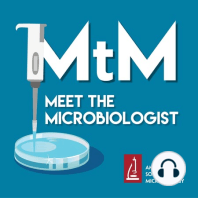24 min listen

081: Developing infectious disease diagnostics with Melissa Miller
081: Developing infectious disease diagnostics with Melissa Miller
ratings:
Length:
43 minutes
Released:
Apr 26, 2018
Format:
Podcast episode
Description
How are new diseases detected in a clinical microbiology lab? Melissa Miller talks about the time it takes to develop a test for a new disease (hint: it’s getting shorter). She also shares her definition of ‘point-of-care’ diagnostics and explains the major trends for clinical microbiology labs. Host: Julie Wolf Subscribe (free) on iPhone, Android, RSS, or by email. You can also listen on your mobile device with the ASM Podcast app. Julie's biggest takeaways: Antibiograms are vital to understand the resistance characteristics of locally circulating disease strains. These help make empirical decisions for antibiotic therapy regimens before the susceptibility test results are available. New diseases require new diagnostic tests. How to determine how well new tests work once they’re developed? Clinical microbiologists look to the sensitivity (how well does a test detect if a patient has a disease) and specificity (how often is the test negative if the patients doesn’t have it) of the test. Having access to positive controls (that is, samples from a patient known to have the disease) can prove difficult in some settings, such as in North Carolina, where no Zika patients were admitted while the Zika virus test was being developed. When the HIV epidemic was beginning, it took several years after the HIV virus was identified to sequence its genome and use this for molecular testing. In 2002-2003, it took just over a month to get the SARS genome sequence for use in developing assays. It’s even quicker today; within a week, we can have sequences from viruses around the world. Defining ‘point-of-care’ testing took an entire hour at a recent American Academy of Microbiology colloquium! Melissa’s take: It’s a test that can be done at or near to where the patient is. Point-of-care tests are exciting but can also pose challenges. A recent example is false-positive pertussis tests that were shown to be due to pertussis vaccine being administered nearby. Ensuring the tests are used safely and accurately will best serve healthcare workers and patients alike. Molecular diagnostics have two trends: one trend simplifies existing technologies into point-of-care tests. The other trend adds complexity, by applying next-generation sequencing techniques in a reproducible manner. Featured Quotes (in order of appearance): “Laboratorians are often in the basement or in a setting where they aren’t visible to the healthcare team, but they’re very vital to taking care of the patient.” “When you’re using laboratory-developed tests, the way it works in one laboratory may be very different from how it works in another laboratory.” “The ultimate goal [of point-of-care testing] is to get a result that’s actionable. We don’t need to do tests that aren’t going to result in a clinically actionable decision.” “In many ways, the technology is ahead of where our quality assurance protocols are.” “I think it’s going to be very important in going ahead that we continue to have laboratorians involved in developing these point-of-care programs and consulting to these sites, helping to make sure that there are policies and procedures that ensure quality results for their patients.” “It’s one thing to do it in a research setting; we’ve collaborated with a number of folks using next generation sequencing. But to then move it to the clinical lab and have it be reproducible and have the quality at the level you need for a clinical lab is a completely different challenge.” Links for this episode Melissa Miller University of North Carolina Website Division of Clinical Laboratory Science at University of North Carolina Searchable List of Clinical Laboratory Science Programs AAM Colloquium Report on Point-of-Care Testing CPEP Program Career Blog: Tips on becoming a clinical microbiology laboratory director HOM Tidbid: Papagrigorakis 2006 International Journal of Infectious Diseases report HOM Tidbit: Shapiro reply to Papagrigorakis report Send yo
Released:
Apr 26, 2018
Format:
Podcast episode
Titles in the series (100)
MTS6 Bruce Rittmann - Microbes, Waste and Renewable Energy by Meet the Microbiologist